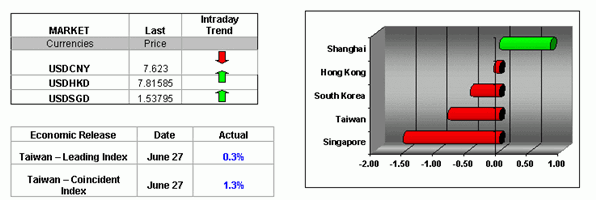| Chinese Stocks Plunge 4 Percent |
| By John Kicklighter |
Published
06/28/2007
|
Currency
|
Unrated
|
|
|
|
Chinese Stocks Plunge 4 Percent
Today, the Shanghai composite index, China’s main stock market index, fell by nearly 4 percent to 3,914.2, amid concern that the PBOC may have to increase the benchmark interest rate to control the existent price and wage pressures. Yi Gang, China’s assistant central bank governor, said his agency is determined to make use of a range of monetary policy tools to curb inflation, including interest rate hikes, according to the China Daily. China's economic growth remains well sustained but a slowing economy in the United States should be a key external risk to the Chinese growth in 2007.

Another Step In Stabilizing China’s Financial Markets
Officials at the China Financial Futures Exchange introduced a new futures contract that would track the CSI 300 Index. Major investment hubs the world over have offered these products, primarily used to hedge adverse price movements in the underlying, for some time. The exchange laid out the standard rules for the contract’s trading. A few of the noteworthy attributes were: a 6 percent daily limit that would hold trading for 5 minutes followed by 10 percent limit; a limit of 600 contracts per investor for each contract month; and a clear allowance for the exchange to liquidate traders positions under certain circumstances. Each contract is valued by multiplying the index’s point level by 300 yuan; and to trade the contact, investors need to put up 10 percent of its overall value. Consequently, this will not be an investment vehicle for the average trader, rather a product that will be utilized by bigger institutions. While some regulatory officials are uncertain over how the product may affect the underlying equities market, it should help to protect against major losses and excessive volatility since short selling is not permitted in Chinese stocks. The exchange has not offered a date for when the contract will begin trading.
Hawkish words from South Korea’s Central Bank governor maintains won’s strength
According to Bloomberg news, “Governor of The Bank of Korea today said that they will maintain efforts to slow money supply growth and cool lending demand. Currently the policy makers are struggling to contain soaring household and business debt that raises the risk of loan defaults and could hamper the economy’s expansion. He also warned that prompt actions can be taken to reduce speculation. The won is close to the strongest in almost 10 years against the yen as investors continue to borrow from Japan and invest in Korea.”
Despite the substantial volatility in the stock market, the Chinese yuan remains very strong
The yuan continued its gradual appreciation against the U.S. dollar closing at 7.6151 on the over the counter market. One year onshore yuan forwards traded at 7.2701 to the dollar, anticipating the yuan will be almost 5 percent stronger in one year's time.
Richard Lee is a Currency Strategist at FXCM.
|